Starting with the Harem area, there is the summer palace.
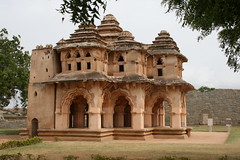 Interestingly enough it specifically has both Hindu and Muslim architecture in it so that it would not be destroyed by members of either faith. It seemed to have worked. The artistry around the doors was still intact in many places, and is really beautiful.
Interestingly enough it specifically has both Hindu and Muslim architecture in it so that it would not be destroyed by members of either faith. It seemed to have worked. The artistry around the doors was still intact in many places, and is really beautiful. 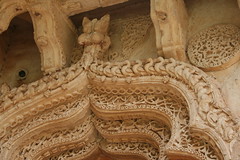 The place had a bit if a magical quality to it. I can certainly see how it would have been a lovely place to be--even if you had to be kept away from all the men.
The place had a bit if a magical quality to it. I can certainly see how it would have been a lovely place to be--even if you had to be kept away from all the men.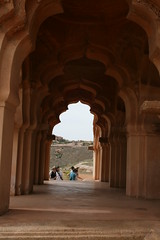 I really enjoyed just walking around this area. The grass was nicely maintained, and there were a number of people working while we were there. From here there was easy access to the Elephant stables.
I really enjoyed just walking around this area. The grass was nicely maintained, and there were a number of people working while we were there. From here there was easy access to the Elephant stables.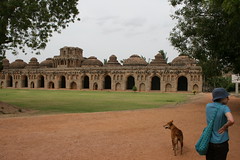 They are a long building with spots for the elephant, and then small communicating doors between the stables for the workers to get around.
They are a long building with spots for the elephant, and then small communicating doors between the stables for the workers to get around. 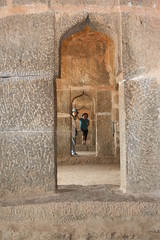 There was also an upstairs / roof which we could not access, but the squirrels seemed to love going up there. We saw several.
There was also an upstairs / roof which we could not access, but the squirrels seemed to love going up there. We saw several.After the Elephant Stable area, we went on to the most grand area, in terms of space. There was even a building (now gone) which had a secret chamber under it. We go to go in it. It was cool to see, but stank of bat guano and other stuff. We didn't want to stay down there too long. There was a grand bath area.
 It was fed by aquaduct, which you can see in the picture. Behind that there was this large elevated area, which was a grand audience hall or something like that. We climbed up the back side, and had a wonderful view. Then we walked down the front.
It was fed by aquaduct, which you can see in the picture. Behind that there was this large elevated area, which was a grand audience hall or something like that. We climbed up the back side, and had a wonderful view. Then we walked down the front.  Then we headed out to go to lunch (at the Mango Tree again). On the way to the car, we walked by these huge stone doors which had been propped up on display. They must have been about 10 feet tall, and had some sort of a metal hinge on the bottom.
Then we headed out to go to lunch (at the Mango Tree again). On the way to the car, we walked by these huge stone doors which had been propped up on display. They must have been about 10 feet tall, and had some sort of a metal hinge on the bottom.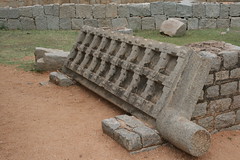 I later heard that there is a temple near Bangalore where there are still doors on like these, but you can no longer visit it because too many people were opening and closing them to hear the sounds they make when moving. In this picture you are looking down from the top at the door.
I later heard that there is a temple near Bangalore where there are still doors on like these, but you can no longer visit it because too many people were opening and closing them to hear the sounds they make when moving. In this picture you are looking down from the top at the door.We had lunch at the Mango Tree again, and on Saturday, Cindy had seen this stone carver who was working near the entrance. She had even bought a piece from him. Sunday she bought 4 little statues / carvings from him.
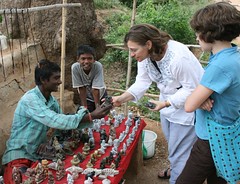
Then after lunch we went on to one of the most beautiful places. The Queen's bath. It is a structure which had water flowing in from an aquaduct, into a room with a bath in it. The water would get 4-5 feet deep. It had a drain out the bottom where the water was then passed to a sort of small moat around the building from which it could be re-directed to agricultural uses. I love this picture because it shows some of the old india, mixed with the new.
 After this, we went back, checked out of the hotel, had a light dinner, and took an uneventful train trip back to Bangalore. Altogether a spectacular weekend. I highly recommend anyone coming to this area to make the trip.
After this, we went back, checked out of the hotel, had a light dinner, and took an uneventful train trip back to Bangalore. Altogether a spectacular weekend. I highly recommend anyone coming to this area to make the trip.

No comments:
Post a Comment